Assessing Wildfire Exposure to Communities and Protected Areas in Portugal
Abstract
:1. Introduction
2. Materials and Methods
2.1. Study Area
2.2. Human Communities and Built-Up Areas
2.3. Protected Natural Sites
2.4. Wildfire Simulation Modeling
2.5. Wildfire Exposure Analysis
3. Results
3.1. Wildfire Likelihood and Intensity
3.2. Wildfire Exposure to Communities
3.3. Wildfire Exposure in Protected Areas
4. Discussion and Conclusions
Author Contributions
Funding
Acknowledgments
Conflicts of Interest
Appendix A. Urban Development Built-Up Classes and Structure Density

| LULC (Code) | LULC (Name) | LULC (Abbreviation) | Area (km2) | Density (# str. km−2) | Density Estimation Data Source |
|---|---|---|---|---|---|
| 1121 | Discontinuous urban fabric | DUF | 1659.1 | 759 | 1 |
| 1112 | Predominantly horizontal continuous urban fabric | HUF | 795.0 | 1,329 | 1 |
| 1122 | Sparse discontinuous urban fabric | SDF | 398.7 | 441 | 1 |
| 1211 | Industrial | IND | 373.6 | 170 | 2 |
| 1512 | Mining sites | MIN | 157.1 | 170 | 3 |
| 1531 | Areas under construction | AUC | 87.0 | 170 | 3 |
| 1111 | Predominantly vertical urban fabric | VUF | 205.7 | 985 | 1 |
| 1231 | Agricultural facilities | AGR | 90.8 | 141 | 4 |
| 1612 | Sport facilities | SPR | 63.0 | 170 | 3 |
| 1651 | Tourism facilities | TUR | 132.2 | 170 | 3 |
| 1312 | Energy infrastructure | ENE | 11.5 | 170 | 3 |
| 1321 | Water depuration sites | WAT | 2.6 | 170 | 3 |
| 1522 | Dumpsters | DUM | 6.4 | 170 | 3 |
| 1431 | Airports | AIR | 27.0 | 170 | 3 |
| 1221 | Commertial sites | COM | 40.0 | 110 | 2 |
| 1622 | Recreation areas | REC | 7.5 | 141 | 4 |
| 1631 | Cultural sites | CUS | 11.2 | 170 | 3 |
| 1641 | Cemeteries | CEM | 9.5 | 170 | 3 |
| 1311 | Infrastructure for renewable energy production | IRE | 17.5 | 170 | 3 |
| 1131 | Parking areas and public areas | PAR | 11.1 | 18 | 1 |
| 1132 | Empty spaces under development | UDE | 35.7 | 26 | 1 |
| 1322 | Waste treatment and wastewater infrastructures | WTR | 15.9 | 170 | 3 |
| 1421 | Sea ports | POR | 8.9 | 170 | 3 |
| 1422 | Shipyards | SYR | 2.2 | 170 | 3 |
| 1423 | Marinas and fishing docks | MFD | 4.5 | 170 | 3 |
| 1432 | Airfields | AFI | 15.8 | 170 | 3 |
| 1511 | Open-pit mines | OMI | 8.0 | 170 | 3 |
| 1521 | Landfill sites | LSI | 10.9 | 170 | 3 |
| 1711 | Parks and gardens | PGA | 41.1 | 141 | 4 |
| 1611 | Golf courses | GCO | 43.8 | 141 | 4 |
| 1621 | Camp sites | CSI | 10.8 | 141 | 4 |
Appendix B. Standard Fuel Model Assignation to Land-Cover Classes
| LULC (Description) | LULC (Code) | Standard Fuel Model (Code) |
|---|---|---|
| Predominantly vertical urban fabric | 1111 | 91 |
| Predominantly horizontal continuous urban fabric | 1112 | 91 |
| Discontinuous urban fabric | 1121 | 91 |
| Sparse discontinuous urban fabric | 1122 | 91 |
| Parking areas and public areas | 1131 | 91 |
| Empty spaces under development | 1132 | 91 |
| Industrial | 1211 | 91 |
| Commercial areas | 1221 | 91 |
| Agricultural facilities | 1231 | 91 |
| Infrastructure for renewable energy production | 1311 | 91 |
| Energy infrastructure | 1312 | 91 |
| Water depuration sites | 1321 | 91 |
| Waste treatment and wastewater infrastructures | 1322 | 91 |
| Road network and associated lands | 1411 | 91 |
| Rail network and associated lands | 1412 | 91 |
| Port areas | 1421 | 91 |
| Shipyards | 1422 | 91 |
| Marinas and fishing docks | 1423 | 91 |
| Airports | 1431 | 91 |
| Airfields | 1432 | 91 |
| Open-pit mines | 1511 | 99 |
| Mining sites | 1512 | 99 |
| Landfill sites | 1521 | 99 |
| Dumpsters | 1522 | 99 |
| Areas under construction | 1531 | 99 |
| Golf courses | 1611 | 93 |
| Sport facilities | 1612 | 93 |
| Camp sites | 1621 | 91 |
| Recreation areas | 1622 | 91 |
| Cultural sites | 1631 | 91 |
| Cemeteries | 1641 | 91 |
| Tourism facilities | 1651 | 91 |
| Parks and gardens | 1711 | 93 |
| Non-irrigated arable land | 2111 | 104 |
| Irrigated arable land | 2111 | 93 |
| Rice fields | 2112 | 93 |
| Vineyards | 2211 | 93 |
| Fruit trees plantations | 2221 | 93 |
| Olive groves | 2231 | 93 |
| Annual crops or pastures associated to vineyards | 2311 | 102 |
| Annual crops or pastures associated to fruit trees plantations | 2312 | 163 |
| Annual crops or pastures associated to olive groves | 2313 | 163 |
| Complex cultivation patterns | 2321 | 104 |
| Land occupied by agriculture, with significant areas of natural vegetation | 2331 | 123 |
| Protected agriculture and nurseries | 2411 | 93 |
| Managed pastures | 3111 | 104 |
| Espontaneous pastures | 3121 | 123 |
| Agro-forestry areas with Quercus suber (cork tree) | 4111 | 163 |
| Agro-forestry areas with Quercus ilex (evergreen oak) | 4112 | 163 |
| Agro-forestry areas with other oaks | 4113 | 163 |
| Agro-forestry areas with Pinus pinea (stone pine) | 4114 | 163 |
| Agro-forestry areas with other species | 4115 | 163 |
| Agro-forestry areas with Quercus suber and Quercus ilex | 4116 | 163 |
| Agro-forestry areas with other mix of species | 4117 | 163 |
| Quercus suber forest (cork tree) | 5111 | 165 |
| Quercus ilex forest (evergreen oak) | 5112 | 165 |
| Other oak forests | 5113 | 165 |
| Castanea forests (chestnut tree) | 5114 | 186 |
| Eucalyptus forest | 5115 | 189 |
| Forests of invasive species | 5116 | 143 |
| Other broad-leaved forests | 5117 | 186 |
| Pinus pinaster forest (maritime pine) | 5121 | 149 |
| Pinus pinea forest (stone pine) | 5122 | 188 |
| Other coniferous forests | 5123 | 144 |
| Scrubs—Northern Portugal < 3 years since last fire | 6118 | 146 |
| Other Scrubs | 6111 | 148 |
| Scrubs—Northern Portugal > 5 years since last fire | 6111 | 149 |
| Scrubs—Southern Portugal > 5 years since last fire | 6117 | 145 |
| Other Scrubs < 3 years since last fire | 6115 | 143 |
| Scrubs—Southern Portugal < 3 years since last fire | 6116 | 143 |
| Interior beaches, dunes, sand | 7111 | 99 |
| Coastal beaches, dunes, sand | 7112 | 99 |
| Bare rocks | 7121 | 99 |
| Sparsely vegetated areas | 7131 | 121 |
| Inland marshes | 8111 | 98 |
| Salt marshes | 8121 | 98 |
| Intertidal flats | 8122 | 98 |
| Natural water courses | 9111 | 98 |
| Modified or artifical water courses | 9112 | 98 |
| Artificial inland water bodies | 9121 | 98 |
| Natural inland water bodies | 9122 | 98 |
| Dams reservoirs | 9123 | 98 |
| Weirs and other reservoirs | 9124 | 98 |
| Ponds | 9125 | 98 |
| Aquaculture sites | 9211 | 98 |
| Salines | 9311 | 98 |
| Coastal lagoons | 9321 | 98 |
| Estuaries | 9331 | 98 |
| Sea and ocean | 9341 | 98 |
Appendix C. Fire Spread Duration Probabilistic Distribution by Macro-Area
| Macroarea (Code) | Fire Spread Duration (min) and Probability (%) | ||||||||||||
|---|---|---|---|---|---|---|---|---|---|---|---|---|---|
| 60 | 75 | 150 | 200 | 300 | 450 | 600 | 750 | 900 | 1050 | 1200 | 1500 | 1800 | |
| ALE (1) | 0.62 | - | 0.33 | - | 0.05 | - | - | - | - | - | - | - | - |
| ALG (2) | 0.73 | - | - | - | - | 0.07 | 0.05 | - | - | 0.15 | - | - | - |
| APO (3) | - | 0.05 | 0.6 | - | 0.2 | 0.1 | - | 0.05 | - | - | - | - | - |
| BAL (4) | - | - | 0.59 | - | 0.11 | 0.21 | - | - | 0.06 | 0.03 | - | - | - |
| BBA (5) | - | 0.26 | - | - | 0.35 | 0.29 | 0.07 | - | - | 0.03 | - | - | - |
| BDO (6) | - | - | 0.63 | - | 0.27 | - | 0.06 | 0.02 | - | 0.02 | - | - | - |
| BLI (7) | - | - | 0.6 | - | 0.15 | - | - | 0.15 | - | 0.1 | - | - | - |
| EBS (8) | - | - | 0.79 | - | 0.04 | - | 0.17 | - | - | - | - | - | |
| WBS (9) | - | - | - | 0.35 | 0.1 | 0.2 | 0.1 | - | 0.05 | - | - | 0.2 | |
| EST (10) | - | 0.44 | 0.42 | - | 0.14 | - | - | - | - | - | - | - | |
| EIN (11) | - | - | 0.4 | - | 0.05 | 0.25 | - | 0.2 | - | - | - | 0.1 | - |
| NTR (12) | - | - | - | - | 0.9 | - | - | 0.05 | - | 0.05 | - | - | - |
| NCI (13) | - | - | - | 0.7 | 0.17 | 0.1 | - | - | 0.03 | - | - | ||
| SER (14) | 0.84 | 0.13 | - | - | - | 0.03 | - | - | - | - | - | ||
Appendix D. Methodological Flowchart of Exposure Assessment
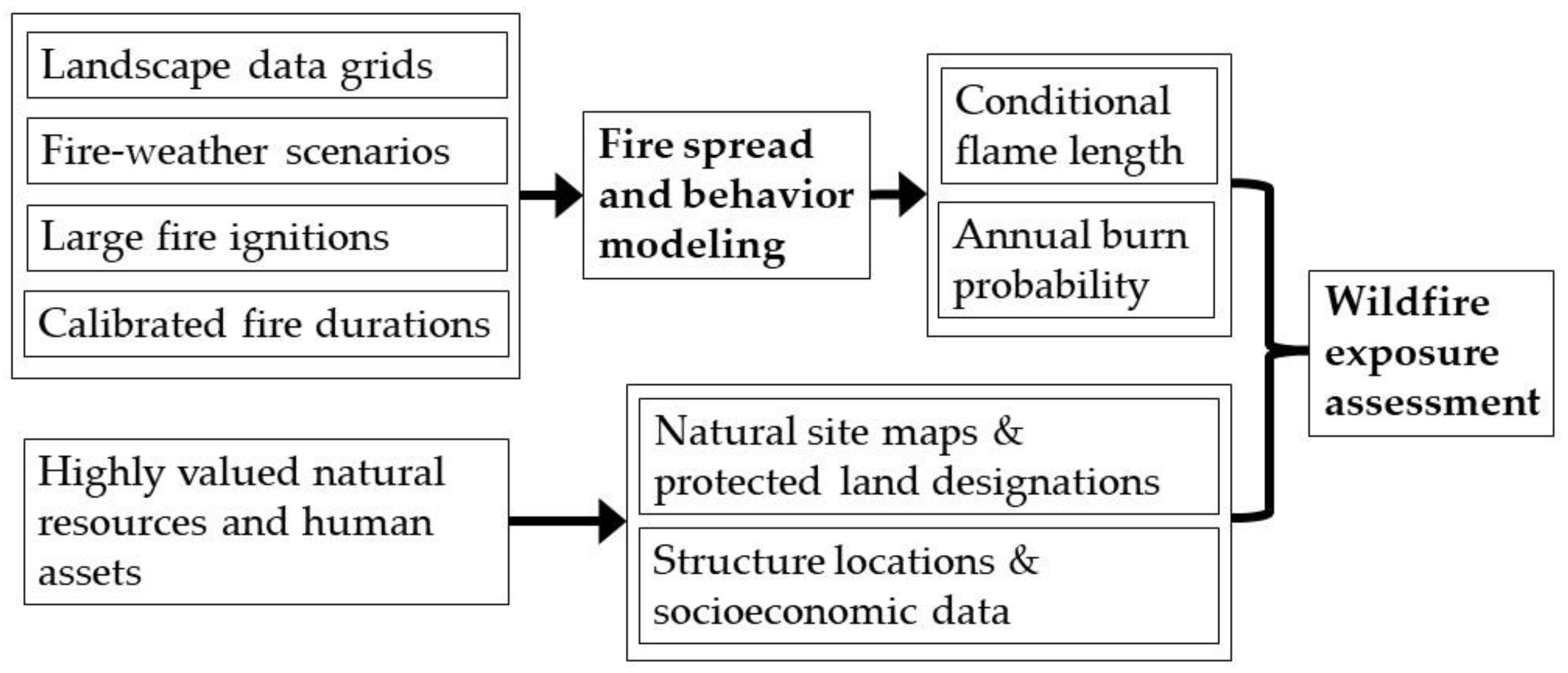
References
- Tedim, F.; Leone, V.; Amraoui, M.; Bouillon, C.; Coughlan, M.R.; Delogu, G.M.; Fernandes, P.; Ferreira, C.; McCaffrey, S.; McGee, T.K.; et al. Defining extreme wildfire events: Difficulties, challenges, and impacts. Fire 2018, 1, 9. [Google Scholar] [CrossRef] [Green Version]
- Molina-Terrén, D.M.; Xanthopoulos, G.; Diakakis, M.; Ribeiro, L.; Caballero, D.; Delogu, G.M.; Viegas, D.X.; Silva, C.A.; Cardil, A. Analysis of forest fire fatalities in Southern Europe: Spain, Portugal, Greece and Sardinia (Italy). Int. J. Wildland Fire 2019, 28, 85–98. [Google Scholar] [CrossRef] [Green Version]
- Salis, M.; Arca, B.; Alcasena-Urdiroz, F.; Massaiu, A.; Bacciu, V.; Bosseur, F.; Caramelle, P.; Dettori, S.; Fernandes de Oliveira, A.S.; Molina-Terren, D.; et al. Analyzing the recent dynamics of wildland fires in Quercus suber L. woodlands in Sardinia (Italy), Corsica (France) and Catalonia (Spain). Eur. J. For. Res. 2019, 138, 415–431. [Google Scholar] [CrossRef] [Green Version]
- Vacca, P.; Caballero, D.; Pastor, E.; Planas, E. WUI fire risk mitigation in Europe: A performance-based design approach at home-owner level. J. Saf. Sci. Resil. 2020, 1, 97–105. [Google Scholar] [CrossRef]
- Curt, T.; Frejaville, T. Wildfire Policy in Mediterranean France: How Far is it Efficient and Sustainable? Risk Anal. 2017, 38, 472–488. [Google Scholar] [CrossRef] [Green Version]
- AGIF. National Plan for Integrated Wildfire Management 2020–2030; Agency for Integrated Rural Fire Management: Lisbon, Portugal, 2020; p. 166. [Google Scholar]
- Ribeiro, L.M.; Rodrigues, A.; Lucas, D.; Viegas, D.X. The impact on structures of the Pedrógão Grande Fire Complex in June 2017 (Portugal). Fire 2020, 3, 57. [Google Scholar] [CrossRef]
- Guerreiro, J.; Fonseca, C.; Salgueiro, A.; Fernandes, P.; Lopez-Iglésias, E.; de Neufville, R.; Mateus, F.; Castellnou, M.; Sande-Silva, J.; Moura, J.M.; et al. Avaliação dos Incêndios Ocorridos Entre 14 e 16 de Outubro de 2017 em Portugal Continental. Relatório Final; Comissão Técnica Independente: Lisboa, Portugal, 2018; p. 274. [Google Scholar]
- San-Miguel-Ayanz, J.; Oom, D.; Artes, T.; Viegas, D.X.; Fernandes, P.; Faivre, N.; Freire, S.; Moore, P.; Rego, F.; Castellnou, M. Forest fires in Portugal in 2017. In Science for Disaster Risk Management 2020: Acting Today, Protecting Tomorrow; Casajus Valles, A., Marin Ferrer, M., Poljanšek, K., Clark, I., Eds.; Publications Office of the European Union: Luxemburg, 2020; pp. 414–430. [Google Scholar]
- Viegas, D.X. Wildfires in Portugal. Fire Res. 2018, 2. [Google Scholar] [CrossRef]
- Oliveira, S.; Rocha, J.; Sá, A. Wildfire risk modeling. Curr. Opin. Environ. Sci. Health 2021, 23, 100274. [Google Scholar] [CrossRef]
- Moreira, F.; Ascoli, D.; Safford, H.; Adams, M.A.; Moreno, J.M.; Pereira, J.M.C.; Catry, F.X.; Armesto, J.; Bond, W.; González, M.E.; et al. Wildfire management in Mediterranean-type regions: Paradigm change needed. Environ. Res. Lett. 2020, 15, 011001. [Google Scholar] [CrossRef]
- Fernandes, P.M.; Guiomar, N.; Rossa, C.G. Analysing eucalypt expansion in Portugal as a fire-regime modifier. Sci. Total Env. 2019, 666, 79–88. [Google Scholar] [CrossRef] [PubMed]
- Sil, Â.; Fernandes, P.M.; Rodrigues, A.P.; Alonso, J.M.; Honrado, J.P.; Perera, A.; Azevedo, J.C. Farmland abandonment decreases the fire regulation capacity and the fire protection ecosystem service in mountain landscapes. Ecosyst. Serv. 2019, 36, 100908. [Google Scholar] [CrossRef] [Green Version]
- Palmero-Iniesta, M.; Espelta, J.M.; Padial-Iglesias, M.; Gonzàlez-Guerrero, Ò.; Pesquer, L.; Domingo-Marimon, C.; Ninyerola, M.; Pons, X.; Pino, J. The Role of Recent (1985–2014) Patterns of Land Abandonment and Environmental Factors in the Establishment and Growth of Secondary Forests in the Iberian Peninsula. Land 2021, 10, 817. [Google Scholar] [CrossRef]
- Espunyes, J.; Lurgi, M.; Buntgen, U.; Bartolome, J.; Calleja, J.A.; Galvez-Ceron, A.; Penuelas, J.; Claramunt-Lopez, B.; Serrano, E. Different effects of alpine woody plant expansion on domestic and wild ungulates. Glob. Chang Biol. 2019, 25, 1808–1819. [Google Scholar] [CrossRef] [PubMed]
- Tavares, A.O.; Monteiro, M.; Barros, J.L.; Santos, P.P. Long-term land-use changes in small/medium-sized cities. Enhancing the general trends and local characteristics. Eur. Plan. Stud. 2019, 27, 1432–1459. [Google Scholar] [CrossRef] [Green Version]
- Bento-Gonçalves, A.; Vieira, A.; da Vinha, L.; Hamada, S. Changes in mainland Portuguese forest areas since the last decade of the XXth century. Mediterranee 2018, 130. [Google Scholar] [CrossRef]
- Meneses, B.; Reis, E.; Pereira, S.; Vale, M.; Reis, R. Understanding Driving Forces and Implications Associated with the Land Use and Land Cover Changes in Portugal. Sustainability 2017, 9, 351. [Google Scholar] [CrossRef] [Green Version]
- Guiomar, N.; Godinho, S.; Fernandes, P.M.; Machado, R.; Neves, N.; Fernandes, J.P. Wildfire patterns and landscape changes in Mediterranean oak woodlands. Sci. Total Env. 2015, 536, 338–352. [Google Scholar] [CrossRef] [PubMed] [Green Version]
- Oliveira, T.M.; Guiomar, N.; Baptista, F.O.; Pereira, J.M.C.; Claro, J. Is Portugal’s forest transition going up in smoke? Land Use Policy 2017, 66, 214–226. [Google Scholar] [CrossRef]
- Fernandes, P.M.; Davies, G.M.; Ascoli, D.; Fernández, C.; Moreira, F.; Rigolot, E.; Stoof, C.R.; Vega, J.A.; Molina, D. Prescribed burning in southern Europe: Developing fire management in a dynamic landscape. Front. Ecol. Environ. 2013, 11, e4–e14. [Google Scholar] [CrossRef] [Green Version]
- Alcasena, F.J.; Evers, C.; Vega-Garcia, C. The Wildland-Urban Interface raster dataset of Catalonia. Data Brief 2018, 17, 124–128. [Google Scholar] [CrossRef]
- Bento-Goncalves, A.; Vieira, A. Wildfires in the wildland-urban interface: Key concepts and evaluation methodologies. Sci. Total Environ. 2020, 707, 135592. [Google Scholar] [CrossRef]
- Resolução do Conselho de Ministros n.º 71-A/2021. Aprova o Programa Nacional de Ação do Plano Nacional de Gestão Integrada de Fogos Rurais. 2021. Available online: https://dre.pt/dre/detalhe/resolucao-conselho-ministros/71-a-2021-164798802 (accessed on 20 May 2021).
- Oliveira, T.M.; Barros, A.M.G.; Ager, A.A.; Fernandes, P.M. Assessing the effect of a fuel break network to reduce burnt area and wildfire risk transmission. Int. J. Wildland Fire 2016, 25, 619–632. [Google Scholar] [CrossRef]
- Calheiros, T.; Pereira, M.G.; Nunes, J.P. Assessing impacts of future climate change on extreme fire weather and pyro-regions in Iberian Peninsula. Sci. Total Env. 2021, 754, 142233. [Google Scholar] [CrossRef] [PubMed]
- Oliveira, S.; Gonçalves, A.; Zêzere, J.L. Reassessing wildfire susceptibility and hazard for mainland Portugal. Sci. Total Environ. 2020, 762, 143121. [Google Scholar] [CrossRef]
- Meira Castro, A.C.; Nunes, A.; Sousa, A.; Lourenço, L. Mapping the Causes of Forest Fires in Portugal by Clustering Analysis. Geosciences 2020, 10, 53. [Google Scholar] [CrossRef] [Green Version]
- Nunes, L.; Álvarez-González, J.; Alberdi, I.; Silva, V.; Rocha, M.; Rego, F.C. Analysis of the occurrence of wildfires in the Iberian Peninsula based on harmonised data from national forest inventories. Ann. For. Sci. 2019, 76. [Google Scholar] [CrossRef] [Green Version]
- Fernandes, P.M. Variation in the Canadian fire weather index thresholds for increasingly larger fires in Portugal. Forests 2019, 10, 838. [Google Scholar] [CrossRef] [Green Version]
- Direção-Geral do Território. Especificações técnicas da Carta de uso e Ocupação do Solo de Portugal Continental para 1995, 2007, 2010 e 2015. Relatório Técnico; Direção-Geral do Território: Lisbon, Portugal, 2018.
- Galizia, L.F.; Curt, T.; Barbero, R.; Rodrigues, M. Assessing the accuracy of remotely sensed fire datasets across the southwestern Mediterranean Basin. Nat. Hazards Earth Syst. Sci. 2021, 21, 73–86. [Google Scholar] [CrossRef]
- Turco, M.; Herrera, S.; Tourigny, E.; Chuvieco, E.; Provenzale, A. A comparison of remotely-sensed and inventory datasets for burned area in Mediterranean Europe. Int. J. Appl. Earth Obs. Geoinf. 2019, 82, 101887. [Google Scholar] [CrossRef] [Green Version]
- Rodrigues, M.; Trigo, R.M.; Vega-García, C.; Cardil, A. Identifying large fire weather typologies in the Iberian Peninsula. Agric. For. Meteorol. 2020, 280, 107789. [Google Scholar] [CrossRef]
- Fernandez-Anez, N.; Krasovskiy, A.; Müller, M.K.; Vacik, H.; Baetens, J.; Hukić, E.; Solomun, M.K.; Atanassova, I.; Glushkova, M.; Bogunović, I.; et al. Current Wildland Fire Patterns and Challenges in Europe: A Synthesis of National Perspectives. Air Soil Water Res. 2021, 14, 1–19. [Google Scholar] [CrossRef]
- San-Miguel-Ayanz, J.; Durrant, T.; Boca, R.; Maianti, P.; Libertà, G.; Vivancos, T.A.; Oom, D.; Branco, A.; De Rigo, D.; Ferrari, D.; et al. Forest Fires in Europe, Middle East and North Africa 2019; Joint Research Centre, European Comission: Luxenburg, 2019; p. 120. [Google Scholar]
- Bergonse, R.; Oliveira, S.; Gonçalves, A.; Nunes, S.; da Câmara, C.; Zêzere, J.L. A combined structural and seasonal approach to assess wildfire susceptibility and hazard in summertime. Nat. Hazards 2021, 106, 2545–2573. [Google Scholar] [CrossRef]
- INE. Instituto Nacional de Estatística: Censos 2011. XV Recenseamento Geral da População: V Recenseamento Geral da Habitação. Resultados Definitivos. Portugal; INE: Lisboa, Portugal, 2012; Available online: https://censos.ine.pt/xportal/xmain?xpid=CENSOS&xpgid=ine_censos_publicacao_det&contexto=pu&PUBLICACOESpub_boui=73212469&PUBLICACOESmodo=2&selTab=tab1&pcensos=61969554 (accessed on 22 May 2021).
- EEA. Nationally Designated Protected Areas (CDDA). Available online: https://www.eea.europa.eu/data-and-maps/data/nationally-designated-areas-national-cdda-15 (accessed on 24 May 2021).
- Dudley, N. Guidelines for Applying Protected Area Management Categories; International Union for Conservation of Nature: Gland, Switzerland, 2008; p. 86. [Google Scholar]
- Finney, M.A. Fire growth using minimum travel time methods. Can. J. For. Res. 2002, 32, 1420–1424. [Google Scholar] [CrossRef]
- Rothermel, R.C. A Mathematical Model for Predicting Fire Spread in Wildland Fuels; INT-115; USDA Forest Service, Intermountain Forest and Range Experiment Station: Ogden, UT, USA, 1972; p. 40.
- Byram, G.M. Forest fire behaviour. In Forest Fire Control and Use; Davis, K., Ed.; McGraw-Hill: New York, NY, USA, 1959; pp. 90–123. [Google Scholar]
- Salis, M.; Arca, B.; Del Giudice, L.; Palaiologou, P.; Alcasena-Urdiroz, F.; Ager, A.; Fiori, M.; Pellizzaro, G.; Scarpa, C.; Schirru, M.; et al. Application of simulation modeling for wildfire exposure and transmission assessment in Sardinia, Italy. Int. J. Disaster Risk Reduct. 2021, 58, 102189. [Google Scholar] [CrossRef]
- Alcasena, F.J.; Ager, A.A.; Bailey, J.D.; Pineda, N.; Vega-Garcia, C. Towards a comprehensive wildfire management strategy for Mediterranean areas: Framework development and implementation in Catalonia, Spain. J. Environ. Manag. 2019, 231, 303–320. [Google Scholar] [CrossRef] [PubMed]
- Ager, A.A.; Lasko, R.; Myroniuk, V.; Zibtsev, S.; Day, M.A.; Usenia, U.; Bogomolov, V.; Kovalets, I.; Evers, C.R. The wildfire problem in areas contaminated by the Chernobyl disaster. Sci. Total. Environ. 2019, 696, 133954. [Google Scholar] [CrossRef]
- Palaiologou, P.; Kalabokidis, K.; Ager, A.A.; Galatsidas, S.; Papalampros, L.; Day, M.A. Spatial optimization and tradeoffs of alternative forest management scenarios in Macedonia, Greece. Forests 2021, 12, 697. [Google Scholar] [CrossRef]
- Ager, A.A.; Vaillant, N.M.; Finney, M.A. Integrating fire behavior models and geospatial analysis for wildland fire risk assessment and fuel management planning. J. Combust. 2011, 572452, 19. [Google Scholar] [CrossRef] [Green Version]
- Scott, J.H.; Burgan, R.E. Standard Fire Behavior Fuel Models: A Comprehensive Set for Use with Rothermel’s Surface Fire Spread Model; RMRS-GTR-153; USDA Forest Service, Rocky Mountain Research Station: Fort Collins, CO, USA, 2005; p. 72.
- EC. Tree Cover Density; Copernicus Emergency Management Service. JRC: E.C.J.R.C.E., Ed. 2018. Available online: https://land.copernicus.eu/pan-european/high-resolution-layers/forests/tree-cover-density/status-maps/tree-cover-density-2018 (accessed on 5 June 2021).
- ICNF. 6.º Inventário Florestal Nacional. 2015 Relatório Final; Instituto da Conservação da Natureza e das Florestas. 2015. Available online: http://www2.icnf.pt/portal/florestas/ifn/resource/doc/ifn/ifn6/IFN6_Relatorio_completo-2019-11-28.pdf (accessed on 25 May 2021). (In Portuguese).
- Muñoz-Sabater, J.; Dutra, E.; Agustí-Panareda, A.; Albergel, C.; Arduini, G.; Balsamo, G.; Boussetta, S.; Choulga, M.; Harrigan, S.; Hersbach, H.; et al. ERA5-Land: A state-of-the-art global reanalysis dataset for land applications. Earth Syst. Sci. Data 2021, 13, 4349–4383. [Google Scholar] [CrossRef]
- Ord, J.K.; Getis, A. Testing for local spatial autocorrelation in the presence of global autocorrelation. J. Reg. Sci. 2001, 41, 411–432. [Google Scholar] [CrossRef]
- ICNF. Fire Database; Institute for Nature Conservation and Forests: Lisbon, Portugal, 2021. [Google Scholar]
- MAPA. Los Incendios Forestales en España. Decenio 2006–2015; Ministerio de Agricultura, Pesca y Alimentación: Madrid, Spain, 2016.
- Tonini, M.; Pereira, M.G.; Parente, J.; Vega Orozco, C. Evolution of forest fires in Portugal: From spatio-temporal point events to smoothed density maps. Nat. Hazards 2016, 85, 1489–1510. [Google Scholar] [CrossRef]
- Finney, M.A.; McHugh, C.W.; Grenfell, I.C.; Riley, K.L.; Short, K.C. A simulation of probabilistic wildfire risk components for the continental United States. Stoch. Environ. Res. Risk Assess. 2011, 25, 973–1000. [Google Scholar] [CrossRef] [Green Version]
- Miller, C.; Ager, A.A. A review of recent advances in risk analysis for wildfire management. Int. J. Wildland Fire 2013, 22, 1–14. [Google Scholar] [CrossRef] [Green Version]
- Alcasena, F.J.; Salis, M.; Ager, A.A.; Castell, R.; Vega-Garcia, C. Assessing wildland fire risk transmission to communities in northern Spain. Forests 2017, 8, 27. [Google Scholar] [CrossRef] [Green Version]
- Lampin-Maillet, C.; Long-Fournel, M.; Ganteaume, A.; Jappiot, M.; Ferrier, J.P. Land cover analysis in wildland–urban interfaces according to wildfire risk: A case study in the South of France. For. Ecol. Manag. 2011, 261, 2200–2213. [Google Scholar] [CrossRef] [Green Version]
- Ager, A.A.; Day, M.A.; Alcasena, F.J.; Evers, C.R.; Short, K.C.; Grenfell, I. Predicting Paradise: Modeling future wildfire disasters in the western US. Sci. Total Environ. 2021, 784, 147057. [Google Scholar] [CrossRef]
- Kramer, H.A.; Mockrin, M.H.; Alexandre, P.M.; Radeloff, V.C. High wildfire damage in interface communities in California. Int. J. Wildland Fire 2019, 28, 641–650. [Google Scholar] [CrossRef] [Green Version]
- Parisien, M.A.; Barber, Q.E.; Hirsch, K.G.; Stockdale, C.A.; Erni, S.; Wang, X.; Arseneault, D.; Parks, S.A. Fire deficit increases wildfire risk for many communities in the Canadian boreal forest. Nat. Commun. 2020, 11, 2121. [Google Scholar] [CrossRef] [PubMed]
- Alcasena, F.J.; Ager, A.A.; Salis, M.; Day, M.A.; Vega-Garcia, C. Optimizing prescribed fire allocation for managing fire risk in central Catalonia. Sci. Total Environ. 2018, 4, 872–885. [Google Scholar] [CrossRef] [PubMed] [Green Version]
- Wunder, S.; Calkin, D.E.; Charlton, V.; Feder, S.; Martínez de Arano, I.; Moore, P.; Rodríguez y Silva, F.; Tacconi, L.; Vega-García, C. Resilient landscapes to prevent catastrophic forest fires: Socioeconomic insights towards a new paradigm. For. Policy Econ. 2021, 128, 102458. [Google Scholar] [CrossRef]
- Ganteaume, A.; Barbero, R.; Jappiot, M.; Maillé, E. Understanding future changes to fires in southern Europe and their impacts on the wildland-urban interface. J. Saf. Sci. Resil. 2021, 2, 20–29. [Google Scholar] [CrossRef]
- USDA Forest Service. The National Strategy: The Final Phase in the Development of the National Cohesive Wildland Fire Management Strategy. 2014. Available online: https://www.forestsandrangelands.gov/strategy/thestrategy.shtml (accessed on 28 May 2021).
- EC. The European Green Deal; European Commission: Brussels, Belgium, 2019; p. 24. [Google Scholar]
- Verkerk, P.J.; Martinez de Arano, I.; Palahí, M. The bio-economy as an opportunity to tackle wildfires in Mediterranean forest ecosystems. For. Policy Econ. 2018, 86, 1–3. [Google Scholar] [CrossRef]
- Turco, M.; Jerez, S.; Augusto, S.; Tarín-Carrasco, P.; Ratola, N.; Jiménez-Guerrero, P.; Trigo, R.M. Climate drivers of the 2017 devastating fires in Portugal. Sci. Rep. 2019, 9, 13886. [Google Scholar] [CrossRef]
- Parisien, M.-A.; Dawe, D.A.; Miller, C.; Stockdale, C.A.; Armitage, O.B. Applications of simulation-based burn probability modelling: A review. Int. J. Wildland Fire 2020, 28, 913–926. [Google Scholar] [CrossRef] [Green Version]
- Salis, M.; Ager, A.A.; Alcasena, F.J.; Arca, B.; Finney, M.A.; Pellizzaro, G.; Spano, D. Analyzing seasonal patterns of wildfire exposure factors in Sardinia, Italy. Environ. Monit. Assess. 2015, 187, 4175. [Google Scholar] [CrossRef] [PubMed] [Green Version]
- San Miguel-Ayanz, J.; Costa, H.; De Rigo, D.; Liberta, G.; Artés, T.; Durrant, T.; Nuijten, D.; Löffler, P.; Moore, P. Basic Criteria to Assess Wildfire Risk at the Pan-European Level; EUR 29500 EN.; European Comission: Ispra, Italy, 2019; p. 23. [Google Scholar]
- Tedim, F.; Leone, V.; Xanthopoulos, G. A wildfire risk management concept based on a social-ecological approach in the European Union: Fire Smart Territory. Int. J. Disaster Risk Reduct. 2016, 18, 138–153. [Google Scholar] [CrossRef]
- Moreira, F.; Viedma, O.; Arianoutsou, M.; Curt, T.; Koutsias, N.; Rigolot, E.; Barbati, A.; Corona, P.; Vaz, P.; Xanthopoulous, G.; et al. Landscape—Wildfire interactions in southern Europe: Implications for landscape management. J. Environ. Manag. 2011, 92, 2389–2402. [Google Scholar] [CrossRef] [PubMed] [Green Version]
- Pra, A.; Masiero, M.; Barreiro, S.; Tomé, M.; Martinez De Arano, I.; Orradre, G.; Onaindia, A.; Brotto, L.; Pettenella, D. Forest plantations in Southwestern Europe: A comparative trend analysis on investment returns, markets and policies. For. Policy Econ. 2019, 109, 102000. [Google Scholar] [CrossRef]
- Moreira, F.; Pe’er, G. Agricultural policy can reduce wildfires. Science 2018, 359, 1001. [Google Scholar] [CrossRef]
- Varela, E.; Górriz-Mifsud, E.; Ruiz-Mirazo, J.; López-i-Gelats, F. Payment for Targeted Grazing: Integrating Local Shepherds into Wildfire Prevention. Forests 2018, 9, 464. [Google Scholar] [CrossRef] [Green Version]
- Canals, R.M. Landscape in motion: Revisiting the role of key disturbances in the preservation of mountain ecosystems. Cuad. Investig. Geográfica 2019, 45, 515. [Google Scholar] [CrossRef] [Green Version]
- García-Ruiz, J.M.; Lasanta, T.; Nadal-Romero, E.; Lana-Renault, N.; Álvarez-Farizo, B. Rewilding and restoring cultural landscapes in Mediterranean mountains: Opportunities and challenges. Land Use Policy 2020, 99, 104850. [Google Scholar] [CrossRef]
- Navarro-Carrión, J.T.; León-Cadena, P.; Ramon-Morte, A. Open data repositories and Geo Small Data for mapping the wildfire risk exposure in wildland urban interface (WUI) in Spain: A case study in the Valencian Region. Remote Sens. Appl. Soc. Environ. 2021, 22, 100500. [Google Scholar] [CrossRef]
- Pereira, J.M.C.; Alexandre, P.M.; Campagnolo, M.L.; Bar-Massada, A.; Radeloff, V.C.; Silva, P.C. Defining and Mapping the Wildland-Urban Interface in Portugal; Imprensa da Universidade de Coimbra: Coimbra, Portugal, 2018. [Google Scholar] [CrossRef] [Green Version]
- Sirca, C.; Casula, F.; Bouillon, C.; García, B.F.; Fernández Ramiro, M.M.; Molina, B.V.; Spano, D. A wildfire risk oriented GIS tool for mapping Rural-Urban Interfaces. Environ. Model. Softw. 2017, 94, 36–47. [Google Scholar] [CrossRef]
- Del Giudice, L.; Arca, B.; Scarpa, C.; Pellizzaro, G.; Duce, P.; Salis, M. The wildland-anthropic interface raster data of the Italy–France maritime cooperation area (Sardinia, Corsica, Tuscany, Liguria, and Provence-Alpes-Côte d’Azur). Data Brief. 2021, 38, 107355. [Google Scholar] [CrossRef] [PubMed]
- Mitsopoulos, I.; Mallinis, G.; Dimitrakopoulos, A.; Xanthopoulos, G.; Eftychidis, G.; Goldammer, J.G. Vulnerability of periurban and residential areas to landscape fires in Greece: Evidence by wildland-urban interface data. Data Brief. 2020, 31, 106025. [Google Scholar] [CrossRef]
- Badia, A.; Pallares-Barbera, M.; Valldeperas, N.; Gisbert, M. Wildfires in the wildland-urban interface in Catalonia: Vulnerability analysis based on land use and land cover change. Sci. Total Environ. 2019, 673, 184–196. [Google Scholar] [CrossRef]
- Madrigal, J.; Ruiz, J.A.; Planelles, R.; Hernando, C. Characterization of wildland-urban interfaces for fire prevention in the province of Valencia (Spain). For. Syst. 2013, 22, 249. [Google Scholar] [CrossRef] [Green Version]
- Calkin, D.E.; Cohen, J.D.; Finney, M.A.; Thompson, M.P. How risk management can prevent future wildfire disasters in the wildland-urban interface. Proc. Natl. Acad. Sci. USA 2014, 111, 746–751. [Google Scholar] [CrossRef] [Green Version]
- Page, W.G.; Butler, B.W. An empirically based approach to defining wildland firefighter safety and survival zone separation distances. Int. J. Wildland Fire 2017, 26, 655. [Google Scholar] [CrossRef]
- Syphard, A.; Keeley, J.E. Factors associated with structure loss in the 2013–2018 California wildfires. Fire 2019, 2, 49. [Google Scholar] [CrossRef] [Green Version]
- Oliveira, S.; Gonçalves, A.; Benali, A.; Sá, A.; Zêzere, J.L.; Pereira, J.M. Assessing risk and prioritizing safety interventions in human settlements affected by large wildfires. Forests 2020, 11, 859. [Google Scholar] [CrossRef]
- Insausti, K.; Beldarrain, L.R.; Lavin, M.P.; Aldai, N.; Mantecon, A.R.; Saez, J.L.; Canals, R.M. Horse meat production in northern Spain: Ecosystem services and sustainability in High Nature Value farmland. Anim. Front. 2021, 11, 47–54. [Google Scholar] [CrossRef]
- Mena, Y.; Ruiz-Mirazo, J.; Ruiz, F.A.; Castel, J.M. Characterization and typification of small ruminant farms providing fuelbreak grazing services for wildfire prevention in Andalusia (Spain). Sci. Total Environ. 2016, 544, 211–219. [Google Scholar] [CrossRef] [PubMed]
- Regos, A.; Aquilue, N.; Retana, J.; De Caceres, M.; Brotons, L. Using unplanned fires to help suppressing future large fires in Mediterranean forests. PLoS ONE 2014, 9, e94906. [Google Scholar] [CrossRef] [Green Version]
- Campos, J.C.; Bernhardt, J.; Aquilue, N.; Brotons, L.; Dominguez, J.; Lomba, A.; Marcos, B.; Martinez-Freiria, F.; Moreira, F.; Pais, S.; et al. Using fire to enhance rewilding when agricultural policies fail. Sci. Total Env. 2021, 755, 142897. [Google Scholar] [CrossRef]
- Riley, K.L.; Thompson, M.P.; Scott, J.H.; Gilbertson-Day, J.W. A model-based framework to evaluate alternative wildfire suppression strategies. Resources 2018, 7, 4. [Google Scholar] [CrossRef] [Green Version]
- Silva, V.; Catry, F.X.; Fernandes, P.M.; Rego, F.C.; Bugalho, M.N.; Marrs, R. Trade-offs between fire hazard reduction and conservation in a Natura 2000 shrub–grassland mosaic. Appl. Veg. Sci. 2019, 23, 39–52. [Google Scholar] [CrossRef]
- Alcasena, F.J.; Salis, M.; Vega-García, C. A fire modeling approach to assess wildfire exposure of valued resources in central Navarra, Spain. Eur. J. For. Res. 2016, 135, 87–107. [Google Scholar] [CrossRef] [Green Version]
- Ager, A.A.; Evers, C.R.; Day, M.A.; Alcasena, F.J.; Houtman, R. Planning for future fire: Scenario analysis of an accelerated fuel reduction plan for the western United States. Landsc. Urban Plan. 2021, 215, 104212. [Google Scholar] [CrossRef]
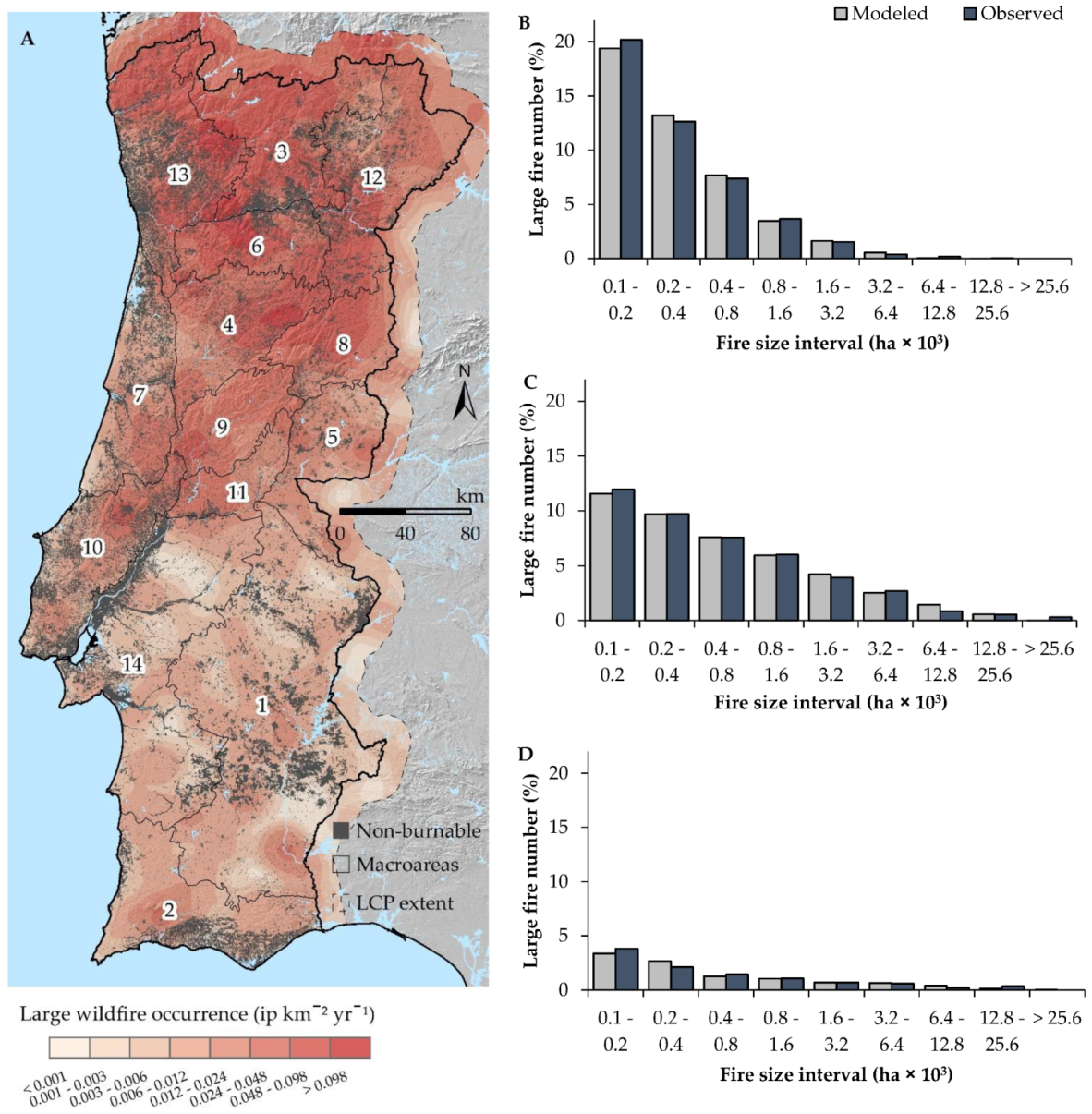
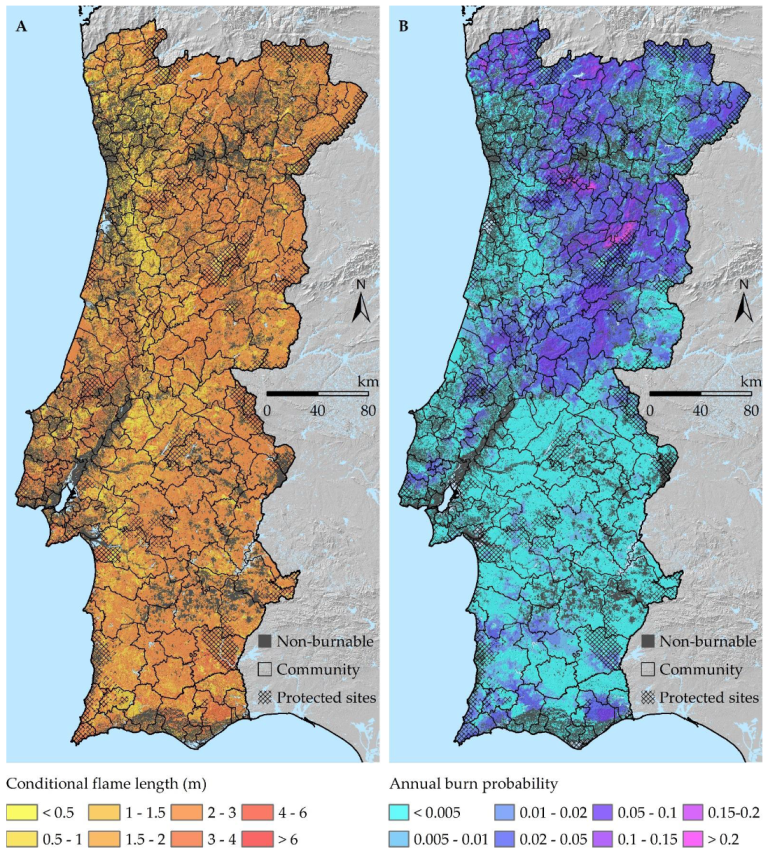
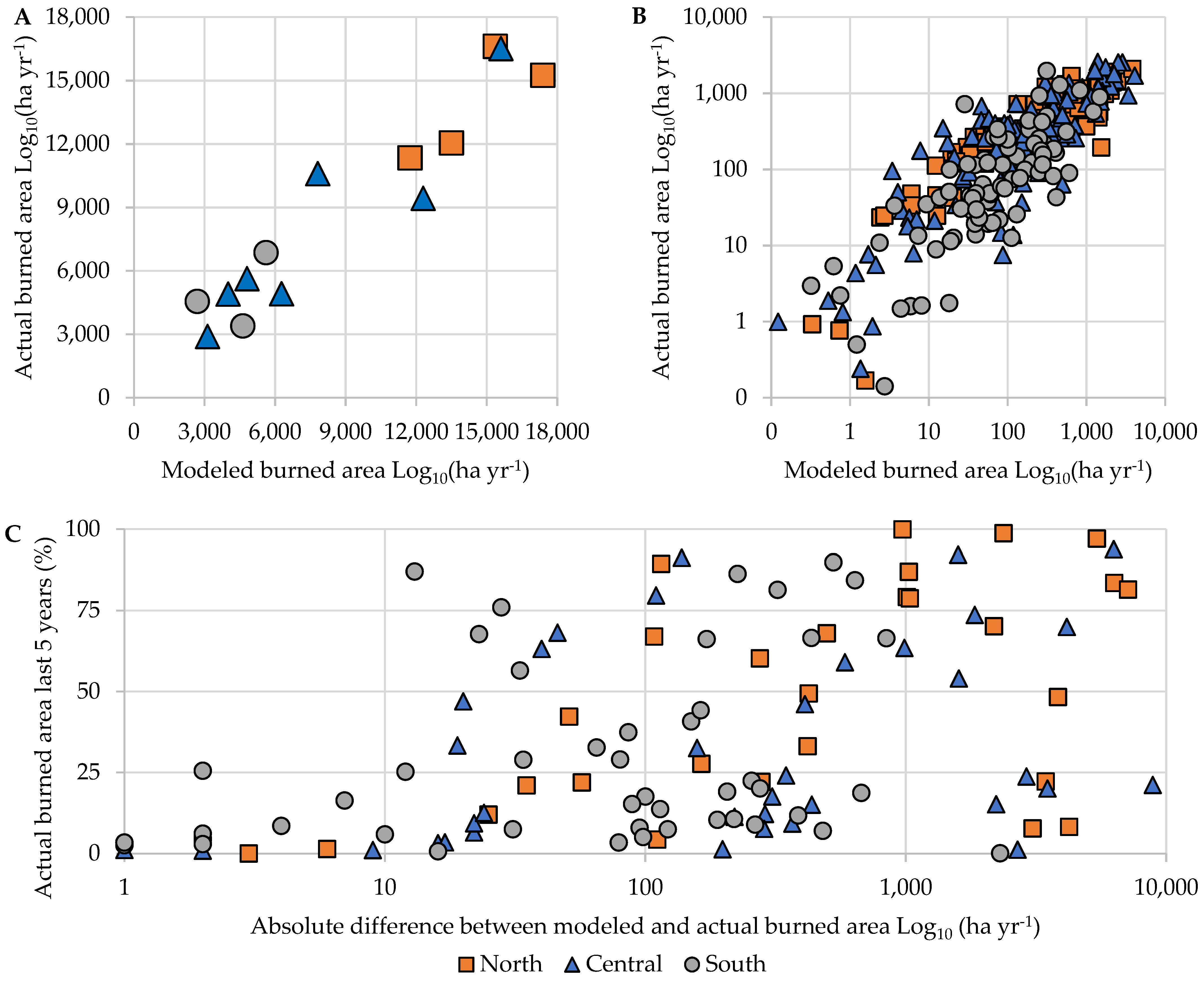

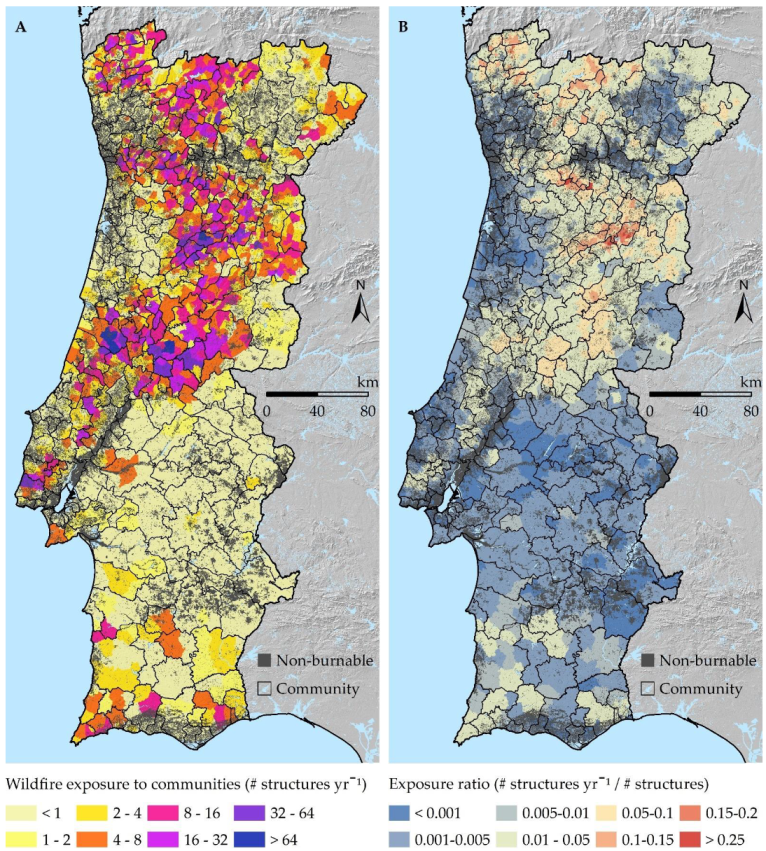
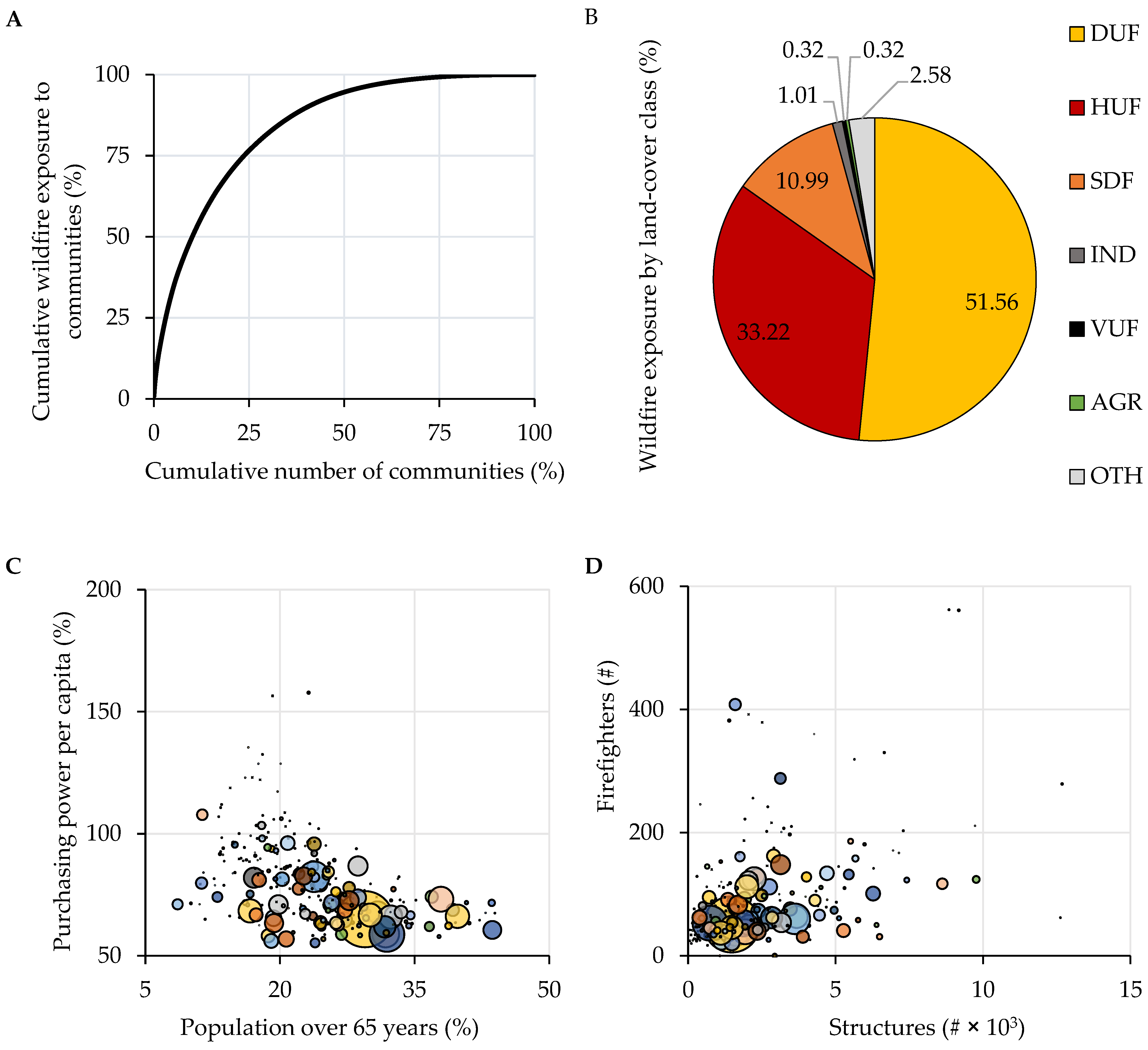
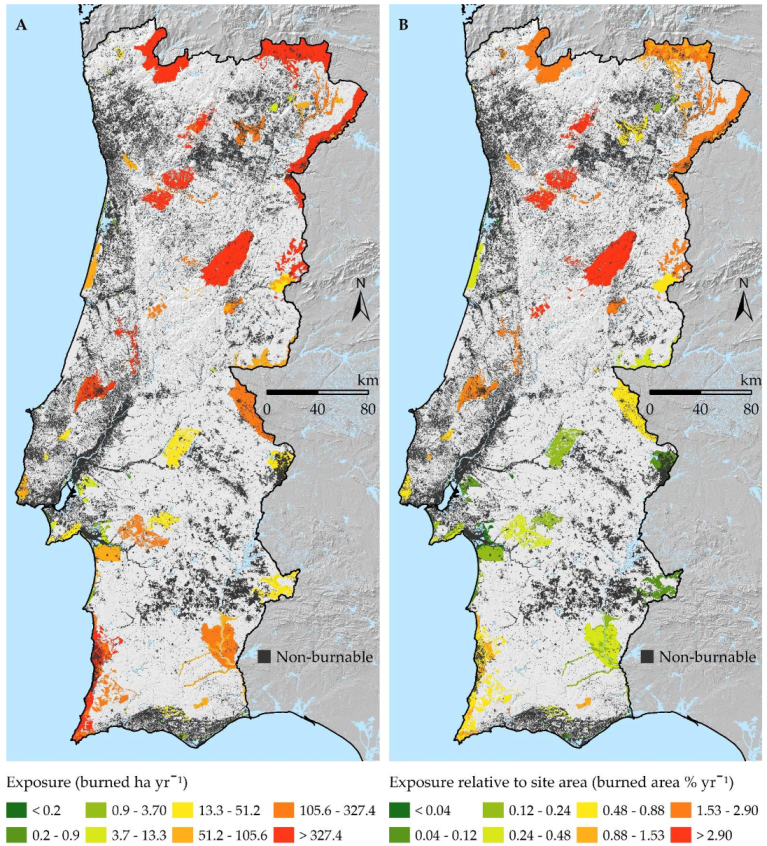
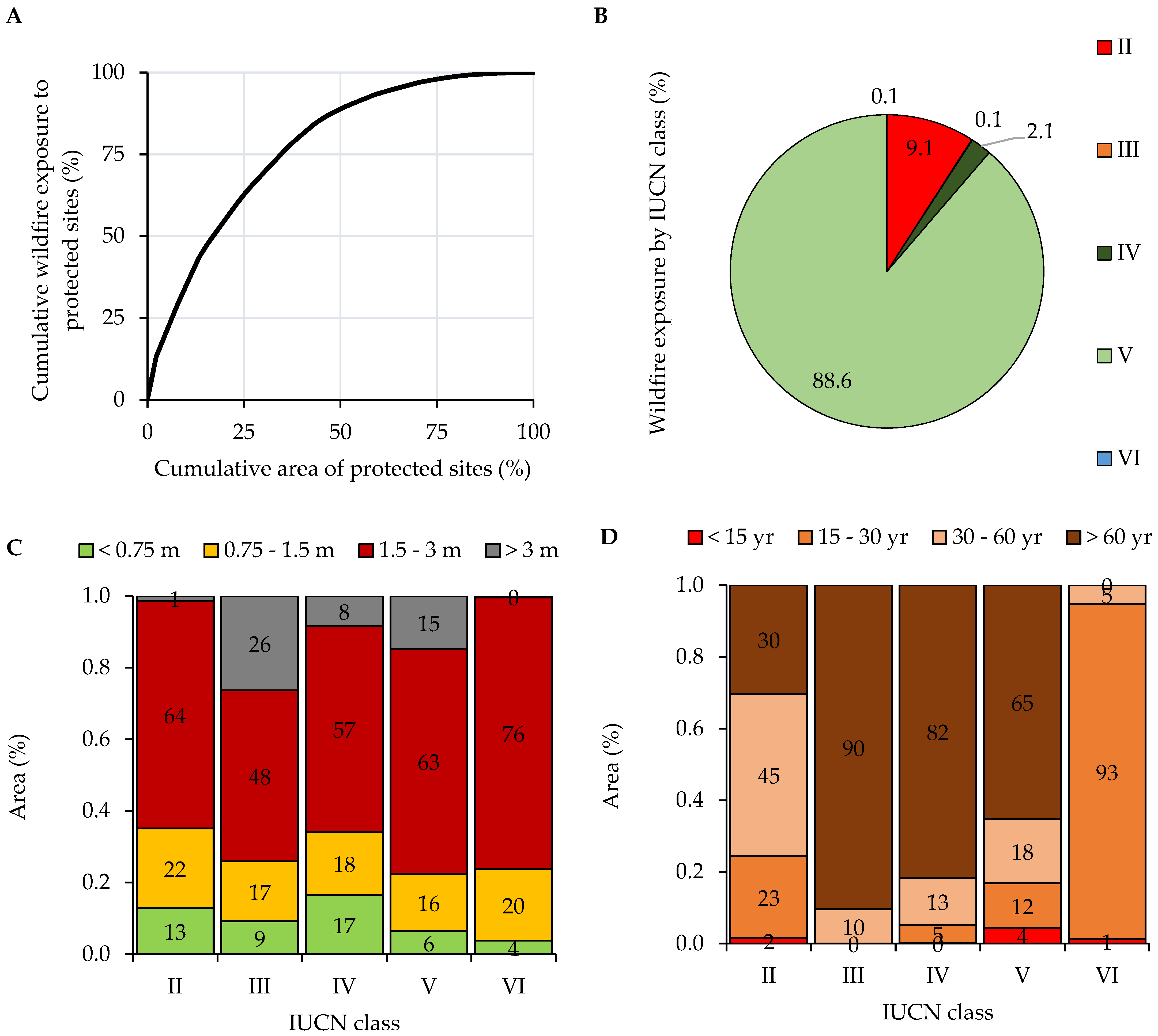
| Macroarea (Code) | Wind Speed (km h−1) and Frequency (%) by Wind Direction Scenario | Fuel Moisture Content (%) | |||||||||||
|---|---|---|---|---|---|---|---|---|---|---|---|---|---|
| 45° | 90° | 135° | 180° | 225° | 270° | 315° | 360° | 1 h | 10 h | 100 h | LH | LW | |
| ALE (1) | - | - | - | 16 (6) | 18 (10) | 18 (20) | 18 (50) | 16 (14) | 4 | 4 | 5 | 29 | 52 |
| ALG (2) | - | - | 24 (6) | 19 (6) | 21 (8) | 21 (12) | 26 (36) | 24 (32) | 6 | 7 | 8 | 32 | 56 |
| APO (3) | 13 (12) | 14 (14) | 14 (6) | 18 (6) | 19 (11) | 16 (22) | 14 (16) | 14 (13) | 7 | 9 | 13 | 38 | 67 |
| BAL (4) | 18 (20) | 18 (12) | - | 23 (6) | 24 (10) | 16 (21) | 18 (22) | 14 (9) | 4 | 7 | 9 | 35 | 62 |
| BBA (5) | 18 (12) | - | - | - | 19 (12) | 18 (30) | 18 (30) | 14 (16) | 5 | 6 | 8 | 34 | 60 |
| BDO (6) | 14 (18) | 16 (15) | - | 21 (6) | 21 (10) | 16 (23) | 16 (18) | 14 (10) | 4 | 9 | 11 | 36 | 64 |
| BLI (7) | 16 (7) | 21 (8) | 26 (5) | 31 (6) | 29 (7) | 21 (8) | 24 (32) | 24 (27) | 4 | 7 | 9 | 39 | 68 |
| EBS (8) | 19 (8) | - | - | 23 (10) | 23 (10) | 18 (14) | 18 (25) | 18 (23) | 6 | 8 | 10 | 37 | 66 |
| WBS (9) | 16 (10) | 18 (8) | - | - | 21 (6) | 19 (12) | 19 (48) | 16 (16) | 3 | 7 | 9 | 37 | 66 |
| EST (10) | - | - | - | - | - | 23 (10) | 26 (45) | 31 (45) | 5 | 6 | 9 | 35 | 62 |
| EIN (11) | 18 (8) | 19 (6) | - | - | 24 (8) | 19 (15) | 21 (51) | 18 (12) | 6 | 7 | 10 | 36 | 64 |
| NTR (12) | 14 (22) | 16 (9) | - | 21 (8) | 21 (13) | 18 (24) | 16 (15) | 13 (9) | 7 | 8 | 10 | 32 | 57 |
| NCI (13) | 14 (12) | 16 (14) | 16 (5) | 24 (8) | 24 (9) | 16 (15) | 19 (22) | 18 (15) | 9 | 12 | 15 | 45 | 70 |
| SER (14) | - | - | - | - | 24 (8) | 19 (16) | 23 (52) | 23 (24) | 5 | 7 | 9 | 34 | 60 |
| Macroarea (Code) | Area (ha) | Burned Area (ha yr−1) | Burned Area (% yr−1) | Avg. Number of Large Fire Ignitions (# yr−1) | Avg. Large Fire Size (ha) |
|---|---|---|---|---|---|
| ALE (1) | 1,857,550 | 3806 | 0.20 | 8.7 | 456 |
| ALG (2) | 611,754 | 6000 | 0.98 | 4.0 | 2615 |
| APO (3) | 647,300 | 17,473 | 2.70 | 2.7 | 457 |
| BAL (4) | 507,460 | 14,719 | 2.90 | 16.6 | 973 |
| BBA (5) | 501,825 | 2867 | 0.57 | 4.0 | 1464 |
| BDO (6) | 338,182 | 12,868 | 3.80 | 15.0 | 530 |
| BLI (7) | 516,748 | 4160 | 0.81 | 5.5 | 1108 |
| EBS (8) | 666,240 | 9821 | 1.47 | 10.9 | 807 |
| WBS (9) | 666,240 | 12,986 | 1.95 | 7.8 | 2538 |
| EST (10) | 658,780 | 2930 | 0.44 | 5.7 | 422 |
| EIN (11) | 658,780 | 6819 | 1.04 | 4.3 | 1598 |
| NTR (12) | 702,152 | 11,195 | 1.59 | 19.1 | 491 |
| NCI (13) | 687,862 | 15,690 | 2.28 | 32.9 | 376 |
| SER (14) | 1,208,855 | 3023 | 0.25 | 3.9 | 1009 |
Publisher’s Note: MDPI stays neutral with regard to jurisdictional claims in published maps and institutional affiliations. |
© 2021 by the authors. Licensee MDPI, Basel, Switzerland. This article is an open access article distributed under the terms and conditions of the Creative Commons Attribution (CC BY) license (https://creativecommons.org/licenses/by/4.0/).
Share and Cite
Alcasena, F.; Ager, A.; Le Page, Y.; Bessa, P.; Loureiro, C.; Oliveira, T. Assessing Wildfire Exposure to Communities and Protected Areas in Portugal. Fire 2021, 4, 82. https://doi.org/10.3390/fire4040082
Alcasena F, Ager A, Le Page Y, Bessa P, Loureiro C, Oliveira T. Assessing Wildfire Exposure to Communities and Protected Areas in Portugal. Fire. 2021; 4(4):82. https://doi.org/10.3390/fire4040082
Chicago/Turabian StyleAlcasena, Fermin, Alan Ager, Yannick Le Page, Paulo Bessa, Carlos Loureiro, and Tiago Oliveira. 2021. "Assessing Wildfire Exposure to Communities and Protected Areas in Portugal" Fire 4, no. 4: 82. https://doi.org/10.3390/fire4040082







